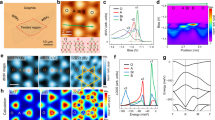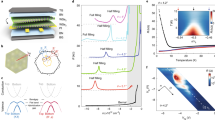Abstract
The crystal structure of a material creates a periodic potential that electrons move through giving rise to its electronic band structure. When two-dimensional materials are stacked, the resulting moiré pattern introduces an additional periodicity so that the twist angle between the layers becomes an extra degree of freedom for the resulting heterostructure. As this angle changes, the electronic band structure is modified leading to the possibility of flat bands with localized states and enhanced electronic correlations1,2,3,4,5,6. In transition metal dichalcogenides, flat bands have been theoretically predicted to occur for long moiré wavelengths over a range of twist angles around 0° and 60° (ref. 4) giving much wider versatility than magic-angle twisted bilayer graphene. Here, we show the existence of a flat band in the electronic structure of 3° and 57.5° twisted bilayer WSe2 samples using scanning tunnelling spectroscopy. Our direct spatial mapping of wavefunctions at the flat-band energy show that the localization of the flat bands is different for 3° and 57.5°, in agreement with first-principles density functional theory calculations4.
This is a preview of subscription content, access via your institution
Access options
Access Nature and 54 other Nature Portfolio journals
Get Nature+, our best-value online-access subscription
$29.99 / 30 days
cancel any time
Subscribe to this journal
Receive 12 print issues and online access
$209.00 per year
only $17.42 per issue
Buy this article
- Purchase on Springer Link
- Instant access to full article PDF
Prices may be subject to local taxes which are calculated during checkout




Similar content being viewed by others
Data availability
Data that support the findings of this study are available from the corresponding authors upon reasonable request. Source data are provided with this paper.
References
Bistritzer, R. & MacDonald, A. H. Moiré bands in twisted double-layer graphene. Proc. Natl Acad. Sci. USA 108, 12233–12237 (2011).
Kang, P. et al. Moiré impurities in twisted bilayer black phosphorus: effects on the carrier mobility. Phys. Rev. B 96, 195406 (2017).
Wu, F., Lovorn, T., Tutuc, E. & Macdonald, A. H. Hubbard model physics in transition metal dichalcogenide moiré bands. Phys. Rev. Lett. 121, 026402 (2018).
Naik, M. H. & Jain, M. Ultraflatbands and shear solitons in moiré patterns of twisted bilayer transition metal dichalcogenides. Phys. Rev. Lett. 121, 266401 (2018).
Chittari, B. L., Chen, G., Zhang, Y., Wang, F. & Jung, J. Gate-tunable topological flat bands in trilayer graphene boron-nitride moiré superlattices. Phys. Rev. Lett. 122, 016401 (2019).
Wu, F., Lovorn, T., Tutuc, E., Martin, I. & Macdonald, A. H. Topological insulators in twisted transition metal dichalcogenide homobilayers. Phys. Rev. Lett. 122, 086402 (2019).
Yankowitz, M. et al. Emergence of superlattice Dirac points in graphene on hexagonal boron nitride. Nat. Phys. 8, 382–386 (2012).
Kim, K. et al. Tunable moiré bands and strong correlations in small-twist-angle bilayer graphene. Proc. Natl Acad. Sci. USA 114, 3364–3369 (2017).
Pan, Y. et al. Quantum-confined electronic states arising from the moiré pattern of MoS2–WSe2 heterobilayers. Nano Lett. 18, 1849–1855 (2018).
Yoo, H. et al. Atomic and electronic reconstruction at the van der Waals interface in twisted bilayer graphene. Nat. Mater. 18, 448–453 (2019).
Choi, Y. et al. Electronic correlations in twisted bilayer graphene near the magic angle. Nat. Phys. 15, 1174–1180 (2019).
Kerelsky, A. et al. Maximized electron interactions at the magic angle in twisted bilayer graphene. Nature 572, 95–100 (2019).
Cao, Y. et al. Correlated insulator behaviour at half-filling in magic-angle graphene superlattices. Nature 556, 80–84 (2018).
Jiang, Y. et al. Charge-order and broken rotational symmetry in magic angle twisted bilayer graphene. Nature 573, 92–95 (2019).
Cao, Y. et al. Unconventional superconductivity in magic-angle graphene superlattices. Nature 556, 43–50 (2018).
Xie, Y. et al. Spectroscopic signatures of many-body correlations in magic-angle twisted bilayer graphene. Nature 572, 101–105 (2019).
Hunt, B. et al. Massive Dirac fermions and Hofstadter butterfly in a van der Waals heterostructure. Science 340, 1427–1430 (2013).
Dean, C. R. et al. Hofstadter’s butterfly and the fractal quantum Hall effect in moiré superlattices. Nature 497, 598–602 (2013).
Ponomarenko, L. A. et al. Cloning of Dirac fermions in graphene superlattices. Nature 497, 594–597 (2013).
Naik, M. H., Maity, I., Maiti, P. K. & Jain, M. Kolmogorov–Crespi potential for multilayer transition-metal dichalcogenides: capturing structural transformations in moiré superlattices. J. Phys. Chem. C 123, 9770–9778 (2019).
Koshino, M. et al. Maximally localized Wannier orbitals and the extended Hubbard model for twisted bilayer. Graphene. Phys. Rev. X 8, 031087 (2018).
Kang, J. & Vafek, O. Symmetry, maximally localized Wannier states, and a low-energy model for twisted bilayer graphene narrow bands. Phys. Rev. X 8, 031088 (2018).
Carr, S., Fang, S., Zhu, Z. & Kaxiras, E. Exact continuum model for low-energy electronic states of twisted bilayer graphene. Phys. Rev. Res. 1, 013001 (2019).
He, J., Hummer, K. & Franchini, C. Stacking effects on the electronic and optical properties of bilayer transition metal dichalcogenides MoS2, MoSe2, WS2, and WSe2. Phys. Rev. B. 89, 075409 (2014).
Yeh, P. C. et al. Direct measurement of the tunable electronic structure of bilayer MoS2 by interlayer twist. Nano Lett. 16, 953–959 (2016).
Liu, K. et al. Evolution of interlayer coupling in twisted molybdenum disulfide bilayers. Nat. Commun. 5, 4966 (2014).
Park, S. et al. Spectroscopic visualization of grain boundaries of monolayer molybdenum disulfide by stacking bilayers. ACS Nano 9, 11042–11048 (2015).
Kim, K. et al. Van der Waals heterostructures with high accuracy rotational alignment. Nano Lett. 16, 1989–1995 (2016).
Zhang, C. et al. Probing critical point energies of transition metal dichalcogenides: surprising indirect gap of single layer WSe2. Nano Lett. 15, 6494–6500 (2015).
Yuan, H. et al. Zeeman-type spin splitting controlled by an electric field. Nat. Phys. 9, 563–569 (2013).
Naik, M. H., Kundu, S., Maity, I. & Jain, M. Origin and evolution of ultraflatbands in twisted bilayer transition metal dichalcogenides: realization of triangular quantum dots. Preprint at https://arxiv.org/abs/1908.10399 (2019).
Acknowledgements
We thank E. Yu for a careful reading of the manuscript. The work at the University of Arizona was supported by the National Science Foundation under grants DMR-1708406 and EECS-1607911 and the Army Research Office under grant no. W911NF-18-1-0420. The work at the University of Texas was supported by the National Science Foundation grants EECS-1610008 and DMR-1720595, the Welch Foundation, and Semiconductor Research Corporation. K.W. and T.T. acknowledge support from the Elemental Strategy Initiative conducted by the MEXT, Japan and the CREST(JPMJCR15F3), JST. K.U. acknowledges support from the JSPS KAKENHI grant no. 25107004.
Author information
Authors and Affiliations
Contributions
Z.Z. performed the STM experiments. Y.W. fabricated the samples for STM measurements. K.W. and T.T. provided hexagonal boron nitride crystals, and K.U. provided the WSe2 crystals. E.T. and B.J.L. conceived the experiments. Z.Z. and B.J.L. performed data analysis and wrote the manuscript with input from all co-authors.
Corresponding authors
Ethics declarations
Competing interests
The authors declare no competing interests.
Additional information
Peer review information Nature Physics thanks Miguel Ugeda and the other, anonymous, reviewer(s) for their contribution to the peer review of this work.
Publisher’s note Springer Nature remains neutral with regard to jurisdictional claims in published maps and institutional affiliations.
Extended data
Extended Data Fig. 1 Stacking configuration of the 57.5° tWSe2 device.
a, Optical image of the 57.5° device. Blue and gray dashed lines highlight the hBN and bilayer graphene flakes respectively. Red dashed lines mark the tWSe2 region. b, Atomic-resolution STM topography on the 57.5° tWSe2 sample, probed at fixed bias voltage of Vbias = 3 V and current I = 100 pA. c, Illustration of the different stacking configurations: BSe/Se, BW/W and AB. For each configuration, the left panel shows the top view and the right panel shows the side view. The blue and cyan colors denote the W atoms, while pink and yellow denote the Se atoms in the two layers.
Extended Data Fig. 2 Filtering of the topography.
a, Atomic-resolution STM topography on the 3° tWSe2 sample, with a fixed bias voltage Vbias = −2.5 V and set current I = 100 pA. b, Fourier transform of panel a. c, Filtered Fourier transform, black area at the center indicates the components being removed. d, Topography image after the short-pass filter was applied, white dashed lines indicate the distance between nearest-neighbor AA sites in 3 different directions.
Extended Data Fig. 3 Local density of states maps at different energies for the 3° tWSe2 device.
a, Lowest energy band at Q in the conduction band. b, Second band at Q in the conduction band. c, Lowest band at K in the conduction band. d, Highest band at K in the valence band. e, second highest band at K in the valence band. None of these images show the hexagonal network as seen at the flat band energy, indicating that the wavefunction of the flat band is distinctively different from the ordinary wavefunctions that arise from the moiré pattern.
Extended Data Fig. 4 dI/dV spectra on the 4 high symmetry points for the 57.5° tWSe2.
a and c Constant height mode dI/dV vs. bias voltage for the valence band and conduction band respectively, acquired at I = 100 pA. b and d, Constant current mode dI/dV vs. bias voltage for the valence band and conduction band respectively, acquired at I = 50 pA.
Extended Data Fig. 5 Line cut dI/dV spectra for the 3° tWSe2 device.
a, Illustration of the line along where the dI/dV spectra was taken. b, Constant current dI/dV spectra line cut, acquired at I = 10 pA. The sharp peak around −1.1 V due to the presence of the flat band shows only a slight spatial variation within the BW/Se-Br-BSe/W region. In contrast, this sharp peak is almost completely missing on the AA sites, indicating that the flat band is localized on the BW/Se-Br-BSe/W region and away from the AA sites.
Supplementary information
Supplementary Information
Supplementary Figs. 1–7 and discussion sections 1–7.
Source data
Source Data Fig. 2
Spectroscopy Source Data for the 3° sample.
Source Data Extended Data Fig. 4
Spectroscopy Source Data for the 57.5° sample.
Rights and permissions
About this article
Cite this article
Zhang, Z., Wang, Y., Watanabe, K. et al. Flat bands in twisted bilayer transition metal dichalcogenides. Nat. Phys. 16, 1093–1096 (2020). https://doi.org/10.1038/s41567-020-0958-x
Received:
Accepted:
Published:
Issue Date:
DOI: https://doi.org/10.1038/s41567-020-0958-x
This article is cited by
-
Crystal net catalog of model flat band materials
npj Computational Materials (2024)
-
Engineering interlayer hybridization in van der Waals bilayers
Nature Reviews Materials (2024)
-
Electric field tunable bandgap in twisted double trilayer graphene
npj 2D Materials and Applications (2024)
-
Tuning commensurability in twisted van der Waals bilayers
Nature (2024)
-
Interlayer exciton dynamics of transition metal dichalcogenide heterostructures under electric fields
Nano Research (2024)



